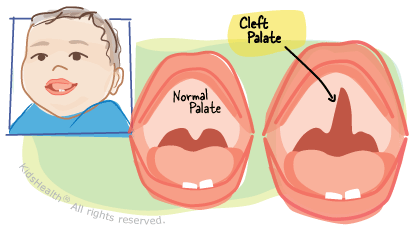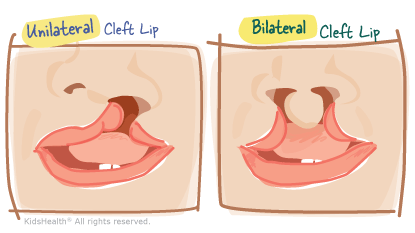Cleft Lip and Palate
Article Translations: (Spanish)
What Is a Cleft?
An orofacial (or-oh-FAY-shul) cleft is when a baby is born with an opening in the lip and/or roof of the mouth (palate). Cleft lip and cleft palate happen is one of the most common birth defects.
Both cleft lip and cleft palate are treatable. Most kids can have surgery to repair them within the first year or two of life.
How Do Clefts Form?
During the first 6 to 10 weeks of pregnancy, the bones and tissues of a baby's upper jaw, nose, and mouth normally come together (fuse) to form the roof of the mouth and the upper lip. A cleft happens when parts of the lip and mouth do not completely fuse together.
A cleft lip may just look like a small opening on the edge of the lip, or it could extend into the nose. It may also extend into the gums. A cleft palate can vary in size. It could affect just the soft palate, which is near the back of the throat, or it also could make a hole in the hard palate toward the front of the mouth.
Most clefts fit into one of three categories:
- cleft lip by itself — most common in boys
- cleft palate by itself — most common in girls
- cleft lip and cleft palate together — more common in boys

Usually, cleft lip is found when a baby is born, although some are seen on a prenatal ultrasound. A cleft palate is more difficult to see until the inside of a child's mouth is examined carefully after birth.
A cleft can be on one side of the mouth (unilateral clefting) or on both sides of the mouth (bilateral clefting).
What Causes Clefts?
Doctors don't always know why a baby develops cleft lip or cleft palate, but many clefts are thought to be a combination of genetic (inherited) and environmental factors (like certain medications or vitamin deficiencies). Both mothers and fathers can pass on a gene or genes that cause cleft palate or cleft lip.
Taking certain medicines (such as some anti-seizure medications) during pregnancy can increase a woman's chances of having a baby with a cleft lip or palate. Similarly, moms who don't get the right amount of prenatal nutrients (for example, not enough folic acid) may increase their baby's risk of having a cleft. A mother's exposure to certain chemicals also may cause a cleft.
Women who smoke cigarettes, use drugs, or drink alcohol during pregnancy also increase their baby's risk for birth defects. Research has shown that moms who binge drink (drinking four or more drinks in a short period of time) during the first weeks of pregnancy have a higher risk of having a baby with a facial birth defect like a cleft lip or cleft palate.
Can a Cleft Cause Other Health Problems?
As you might imagine, cleft lip and cleft palate can affect many actions of the mouth and face. Children born with cleft lip or cleft palate might have issues related to their feeding, hearing, teeth, and speech.
Feeding Problems
Babies with just a cleft lip don't usually have feeding problems. But when the palate is involved, feeding can be a bigger challenge.
Normally, the palate prevents food and liquids from entering the nose. A cleft palate causes babies to swallow a lot of air and regurgitate food into the nose. It also makes it harder for babies to latch on and suck during breastfeeding or bottle feeding. As a result, a baby with a cleft palate may need a special nipple and bottle to receive pumped breast milk or formula. Breastfeeding moms might want to talk with a lactation consultant, who can offer more guidance and suggestions.
Babies with feeding issues should be seen regularly by a doctor to make sure that they're gaining weight well.
Middle Ear Fluid Buildup and Hearing Loss
Many children with cleft palate are at risk for fluid buildup in the middle ear. This fluid can't pass through the Eustachian (yoo-STAY-shun) tube as it should, which can lead to ear infections and even hearing loss. So kids with cleft palate usually need ear tubes placed in their eardrums to help drain the fluid and improve hearing.
Kids with cleft palate should have their ears and hearing checked once or twice a year, or more if they are having hearing problems.
Dental Problems
Children with a cleft lip and palate often have dental problems. These can include small teeth, missing teeth, extra teeth (called supernumerary), or teeth that are out of position. They may have a defect in the gums or alveolar ridge (the bone that supports the teeth). Ridge defects can displace, tip, or rotate permanent teeth or prevent permanent teeth from coming in properly.
Regular visits with a pediatric dentist who specializes in cleft lip and palate are important. The dentist will check a child's mouth growth and development, identify any problems, and make treatments when needed.
Speech Problems
Kids with cleft lip have fewer speech problems than those with cleft palate. About 1 in 5 kids with cleft palate have speech problems after surgical repair. Most often, this means that a child's voice is hypernasal (sounding like the child is talking through the nose). This happens because the palate doesn't move well enough to prevent air from leaking out of the nose.
Children with clefts also can have other types of speech problems that aren't to the cleft; for example, age-related errors such as saying "wed" instead of "red." Sometimes, the dental problems associated with the cleft will distort some sounds, particularly "s," "sh," "ch," and "j."
A speech-language pathologist can check a child's speech and language skills and recommend treatment if needed.
How Are Clefts Treated?
If your child has a cleft lip and/or palate, your pediatrician will talk to you about a cleft lip and palate treatment team. This team of health care professionals will work together to meet your family's needs and, ultimately, help your child transition to adult care.
Besides the pediatrician, your child's treatment team may include:
- plastic surgeon
- ear, nose, and throat physician (otolaryngologist)
- oral surgeon
- orthodontist
- dentist
- speech-language pathologist
- audiologist
- nurse
- social worker
- psychologist or therapist
- geneticist
- team coordinator
Your child might visit this care team a few times a year, depending on his or her needs. Who is seen during a visit depends on the care team's structure and your child's needs. The team coordinator will help organize the visits, and the team should communicate with your doctor about the treatment plan.
Surgical Treatment
A cleft lip is usually surgically repaired in the hospital using general anesthesia when a child is 3 to 6 months old. If the cleft lip is wide, special procedures like lip adhesion or a molding plate device might help bring the parts of the lip closer together before the lip is fully repaired. Cleft lip repair usually leaves a small scar on the lip under the nose.
At 9-12 months of age, a cleft palate usually can be repaired. Plastic surgeons connect the muscles of the soft palate and rearrange the tissues to close the cleft. This surgery requires general anesthesia and a short hospital stay for recovery.
The goal of surgery is to create a palate that works well for speech. Some kids, however, will continue to sound nasal after cleft palate repair, and some may develop a nasal voice later on.
More surgeries may be needed as children grow older and their facial structure changes — this can include surgeries like pharyngoplasty, which helps improve speech, or alveolar bone grafts, which help provide stability for permanent teeth. A bone graft closes gaps in the bone or gums near the front teeth and is usually done when kids are between 6 and 10 years old.
As children become teens, they will likely want to (and should) be more involved in their care. They may want to have their scars made less noticeable, improve the appearance of their nose and upper lip, or improve their bite with orthognathic surgery. These operations may improve speech and breathing, overbites/underbites, and appearance.
Dental and Orthodontic Treatment
Maintaining healthy teeth and preventing cavities is very important for kids with cleft lip and palate, who can have more dental problems than other kids. They should see a dentist regularly and brush and floss every day.
Kids with cleft lip and palate may begin orthodontic treatment as early as 6 years of age. It may start with palatal expansion, a process that makes the width of the palate normal. Later, it may involve braces to position the teeth. Your orthodontist will discuss these issues with you.
Some kids with a cleft might be missing a permanent tooth, which can be replaced with a removable appliance or, in early adulthood, a dental implant.
Speech Therapy
Some kids will need speech therapy after a repair is done. The speech-language pathologist will closely monitor your child's progress and talk with you about whether therapy is needed.
How Can I Help My Child?
It can be hard when kids miss school for frequent doctor's appointments, or when speech problems prevent them from communicating well with their peers. In spite of these and other social, psychological, and educational challenges, kids with clefts just want to be treated like everyone else.
Children may face teasing and bullying because of how a cleft lip and palate look. If your child is teased, talk about it and be a patient listener. Try to give your child tools to confront teasers. Find out what your child would like to say to them and practice it together.
Some kids struggle growing up with a cleft lip or cleft palate and might need help handling certain situations. The psychologists and social workers on the treatment team can help guide you through these difficult times, so turn to them if your child needs added support. The good news is that most kids with cleft lip or cleft palate grow up to be healthy, happy adults.
As your child nears the teen years, remember that your interactions may change. You could be his or her greatest confidante, or your child may not share his or her worries with you. Either way, stay open to communication and support your child with these tips:
- Encourage your child to be confident and not allow the cleft to define who he or she is.
- Make your home a warm, supportive, and accepting place where individual worth and accomplishments are celebrated.
- Encourage your child's friendships and relationships. Make friends with people who are different from you and lead by example.
- As for all kids, being involved in sports, music, and other activities will go a long way toward helping kids with clefts realize their self-worth.
- Give your child the freedom to make decisions and take appropriate risks. Having chances to make decisions early on — like picking out which clothes to wear or foods to eat — gives kids the confidence and skills to make bigger decisions later. It will help them become more independent.
- If your child — especially a young child — wants to talk to the class about cleft lip and palate, set up something with the teacher. Consider asking someone from the treatment team to attend. But remember that your child may need an extra boost of confidence to get up in front of the class, so give lots of encouragement.
Note: All information is for educational purposes only. For specific medical advice, diagnoses, and treatment, consult your doctor.
© 1995-2024 KidsHealth ® All rights reserved. Images provided by iStock, Getty Images, Corbis, Veer, Science Photo Library, Science Source Images, Shutterstock, and Clipart.com

